In this article:
- Which messaging apps can you use to send out marketing notifications?
- Why should you send out push notifications on messaging apps
- Sending WhatsApp notifications
- Using Facebook Messenger from Meta to send out marketing notifications
- Telegram Messenger: The easy messaging app for marketing notifications
- Apple Messages for Business (iMessage): 360 service
- Finding the right content strategy for your one-to-many messages
- How to get subscribers for your messaging notifications
- Send marketing notifications on all relevant messaging apps with "Campaigns", a professional and scalable tool
Sending marketing notifications on messaging apps like WhatsApp, Telegram, or iMessage is a huge opportunity for companies. They offer top click-through and open rates, high engagement, and (almost) real-time delivery. This makes notifications on messaging apps the ultimate tool in your mobile marketing kit!
The e-mail notification is out, the messaging notification is in! Why? Because instead of despairing over low click-through rates with e-mail newsletters, marketing notifications sent on messaging apps like WhatsApp, Facebook Messenger, Telegram, or iMessage offer your company a channel where incredible open rates and high engagement are guaranteed.
In this guide, we'll explain why that is, which messaging apps you can use to send marketing notifications, and how other companies are using them to better reach their customers.
Which messaging apps can you use to send out marketing notifications?
With the growing popularity of messaging among users, messaging apps have started offering various ways for businesses to send out notifications to customers directly in-app. From WhatsApp and Telegram to Apple Messages for Business, just about every messenger service nowadays offers a push notification option.
Depending on the use case and app, you might see different names, such as newsletter, broadcast, marketing notification, or push notifications. The idea is always the same, though: using messaging apps send out push notifications to interact with (potential) customers.
Each service has certain advantages. While Apple Messages for Business is ideal for easily reaching Apple users, WhatsApp allows you to reach people throughout the UK, India or Brazil on their favorite messenger, and Telegram offers marketing notification free of charge.
So, depending on the target group, company and market, one service may be more advantageous than the other, or it might even be worth considering a combination of several services.
Why should you send out push notifications on messaging apps
Notifications that businesses send out to customers proactively are considered push communication in messenger marketing, and they refer to regular information that companies send out to interested users, such as a news updates or a special offer. They help build a long-term relationship with customers and strengthen brand awareness. The only problem is that the traditional messaging channel in marketing, e-mail, is currently going through a crisis.
Overcrowded inboxes, a massive amount of newsletters every day, and users who don't have time or don't want to read through all the newsletters they've subscribed to at one time or another, mean that e-mail notifications are increasingly being ignored or even perceived as spam.
Advantages of notifications on messenger apps
Messenger app notifications, on the other hand, have a major advantage: they land directly in people's most-used apps, typically on the lock screen — and there they get the users' full attention. Accordingly, messaging apps offer incredible open rates of over 90 percent and click-through rates of 35%. In comparison, the click-through rate for e-mails is just 3%, and on social media channels it's only 5%.

Push marketing via messenger apps is therefore popular with organizations and companies alike, especially in media and e-commerce. The reasons for this are:
- Reach: You can reach around 95% of your recipients (on social media, it's around 10%).
- Click-through rate: 35% (e-mail: 3%, social media: 5%, banners: 1%).
- Real-time: The push message is sent in real time. There are no delays in receiving it.
- Lock screen: Push notifications on messenger apps land directly on the lock screen amid messages from friends or family.
- No algorithms: Unlike social media, there is no algorithm in direct messaging. Messages reach the recipient immediately and receive their full attention.
- No spam filter: newsletters arrive directly and do not end up in the spam folder, as is often the case with e-mails.
- Multimedia possibilities: In e-mail campaigns, you can never be sure if your multimedia is displayed. On messaging apps, however, your thoughtfully crafted marketing messages won't be blocked, and you can create much more engaging campaigns.
This makes push notifications on messaging apps an increasingly attractive channel for customer communication for companies. And the various messenger services offer different options.
Sending WhatsApp notifications
After WhatsApp had temporarily discontinued the service, in 2021 WhatsApp re-launched their popular broadcasting feature. With a new price model, the WhatsApp notifications offer better spam protection for users and more options for companies.
WhatsApp distinguishes between four types of conversations between businesses and customers.
- Utility conversations: Business-initiated conversations relating to a transaction, including post-purchase notifications and recurring billing statements to customers who have opted in.
- Authentication: Business-initiated conversations that enable businesses to authenticate users with one-time passcodes at multiple steps during the login process, such as account registration, account recovery, and integrity challenges.
- Marketing conversation: Business-initiated conversations to market a product or service to customers, such as relevant offers to customers who have opted in. Any business-initiated conversation that does not qualify as an authentication or utility conversation would also fall under this category.
- Service conversations: Any user-initiated conversation, such as to resolve a customer inquiry.
The third category, marketing conversation, corresponds to the classic newsletter or push notification businesses send to users.
Push on WhatsApp: From special offers to job alerts
WhatsApp marketing conversations can be extremely versatile and allow for many different use cases.
Relevant news
Obviously, the classic push communication approach is to send out a newsletter, with relevant news alerts that companies send to subscribers at regular intervals (after a previous opt-in!).
Bloomberg Quint, an Indian joint venture of Bloomberg News and Quintillion Media founded in 2016, for example, provides decision-makers and executives with relevant real-time financial market information via WhatsApp.
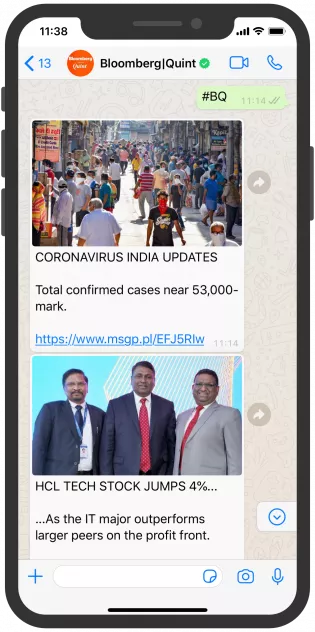
Service Alerts
Another form of push messages via WhatsApp notification are alerts (utility conversations). This could be public service announcements from your local electricity provider or important updates from your airline regarding your flight. Keep in mind though that you can only send out alerts to your WhatsApp customers with their prior consent.
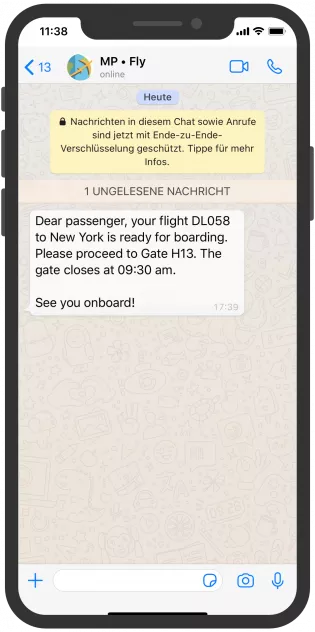
Job alerts
Another creative option for WhatsApp push communication is to send out job alerts. KCS Medical, for instance, is a medical recruitment company that sends out alerts to help people find jobs in the medical field through a WhatsApp newsletter, and with the help of WhatsApp chatbot Zoe.
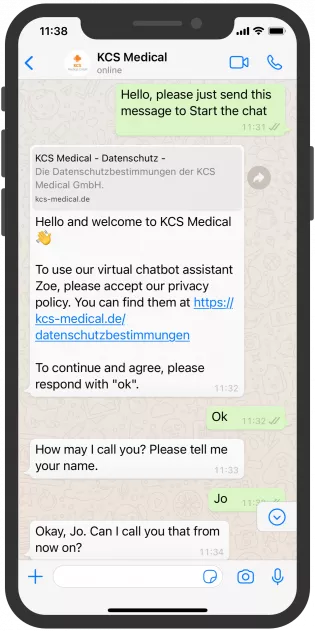
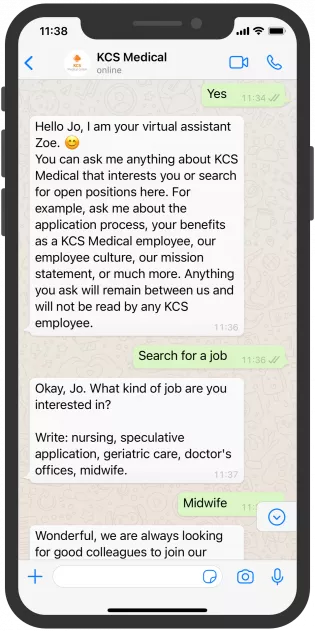
Pull on WhatsApp: The user starts the communication
Even though push notifications is the classic way for marketers and companies to approach customers, push marketing is moving towards conversational marketing. In conversational marketing, interacting with customers is no longer about overwhelming customers with messages they never asked for, but about providing them with the information they really want, when they want it.
The difference to traditional push messages is that interest and the request for receiving information come directly from the customers. As a company, you thus draw customers to you (pull communication).
Customers tell companies what interests them
This gives customers the opportunity to access content by keyword or hashtag exactly when they need it. It also ensures that company messages are not perceived as spam and that better customer loyalty can be built. This form of communication is ideal for sending out coupons or special offers. Yet, there are also many other ways to work with pull-style notifications.
The Indian fact-checking organization Newschecker, for example, gives their subscribers the option to choose what service they want to use. In their case, a reader might have a story they would like Newschecker to fact-check, while others might be interested in receiving the latest fact-checked news directly to their WhatsApp.
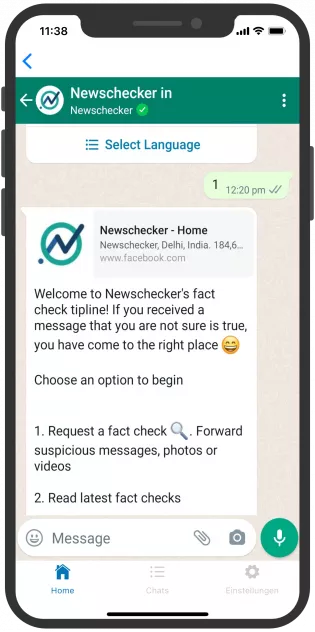
These examples show that the WhatsApp marketing notifications have another great strength in addition to their reach: they give you a lot of options. Companies can thus develop very creative forms of customer communication.
Using Facebook Messenger from Meta to send out marketing notifications
Meta's Facebook Messenger is one of the most popular messaging apps worldwide, with more than 900 million users around the world.
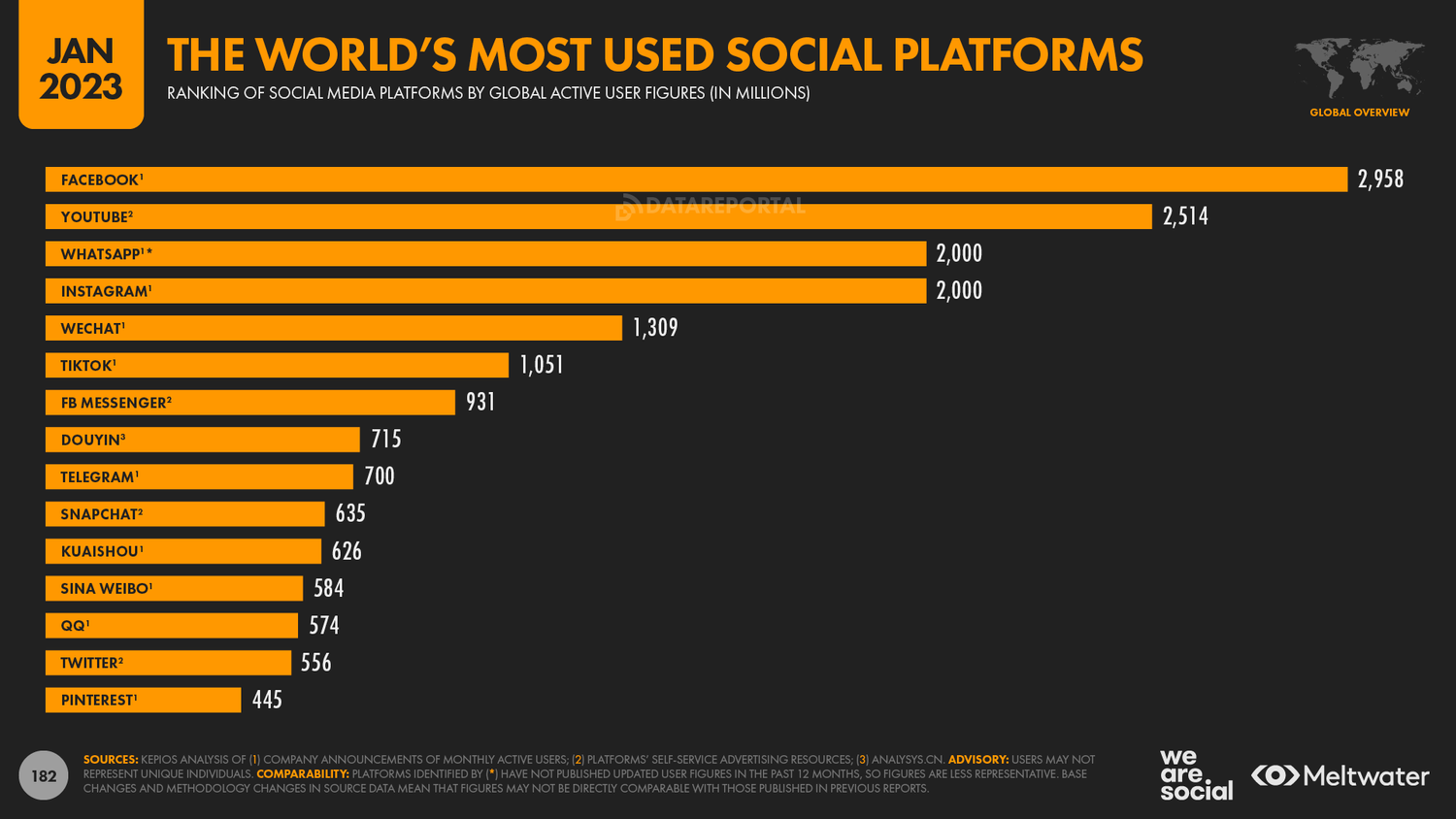
It can therefore be a very powerful channel for reaching customers. In fact, the Messenger on Facebook offers companies two options for sending news, namely subscription messages and sponsored messages.
Subscription Messages
When push notifications via Facebook Messenger first started out, every business had access to them. Then, Meta restricted their use, and from 2020 to 2022 only allowed media publications that were registered through the News Page Index (NPI) to use the service. However, at the Conversations Conference in May 2022, Meta again reopened Facebook notifications to all businesses. Since then, all businesses can once again send recurring messages.

It'll be interesting to see how companies will use the new notification tool in the future, as it's at least as diverse as the WhatsApp notifications.
Recurring notifications on Instagram
With two billion users and an in-app messaging chat, Instagram is probably one of the most interesting social media channel for companies. Especially the combination of drawing users toward your brand with visual content, and then further engage them with direct messaging, makes Instagram unique.
That's why it was really exciting to hear that Meta has announced that they also want to introduce notifications for Instagram Direct as well.
💡 Tip: In addition, Facebook and Instagram can also be great platforms to guide users to your WhatsApp broadcasts, either through a click-to-WhatsApp ad or a call to action on your Facebook Page.
Telegram Messenger: The easy messaging app for marketing notifications
As of June 2022, Telegram counts 700 million users world-wide, and it's currently one of the fastest-growing messaging apps globally. Many of the users turn to Telegram because they're looking for an alternative to WhatsApp, Facebook Messenger, or Instagram Direct. This means that companies can reach a different target group here than on other messenger apps.
Similar to other messenger apps, companies can also send notifications on Telegram. Here it's called "subscription". The subscription feature is similar to WhatsApp broadcasts and works with the help of commands. There is a key advantage of Telegram over the other messaging apps, though: users can easily search for companies and subscribe to their updates through the Discover feature.
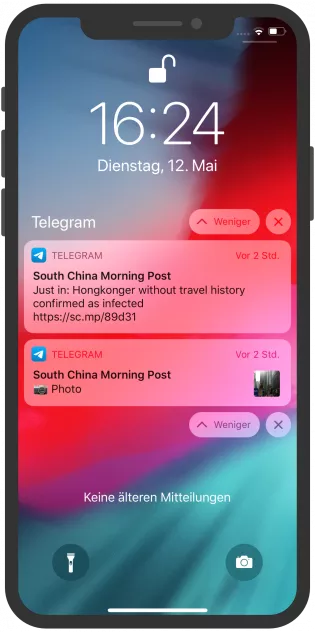
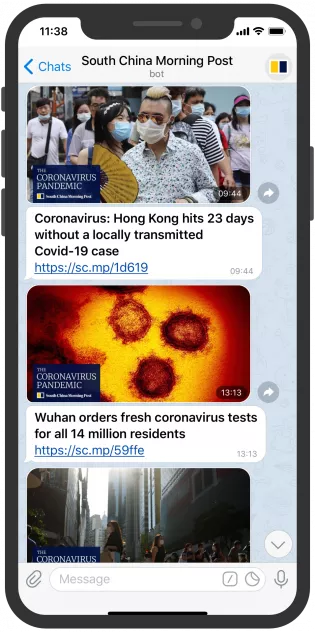
More options with bots
In addition, companies can easily create chatbots on Telegram. These become particularly relevant when it comes to automating the dialogue with customers. For example, bots can take over the prequalification of an inquiry and automatically answer recurring questions. Or, when sending out notifications, you can also use bots to ask subscribers for preferences, such as language or update frequency.
Unlike on WhatsApp, Telegram notifications are (still) free of charge, so especially if you typically send out your marketing notifications to a large number of users, this can be an interesting alternative.
Apple Messages for Business (iMessage): 360 service
Apple Messages for Business was launched in 2018, and is the professional version of iMessage. While iMessage is only for private communication, Apple Messages for Business is exclusively intended as a communication channel between individuals and businesses.
Apple Messages for Business offers companies the opportunity to get in touch with customers directly on the messaging app on an iOS device. Through these notifications, businesses can send content to customers in real time, and the messages appear directly on the locked screen.
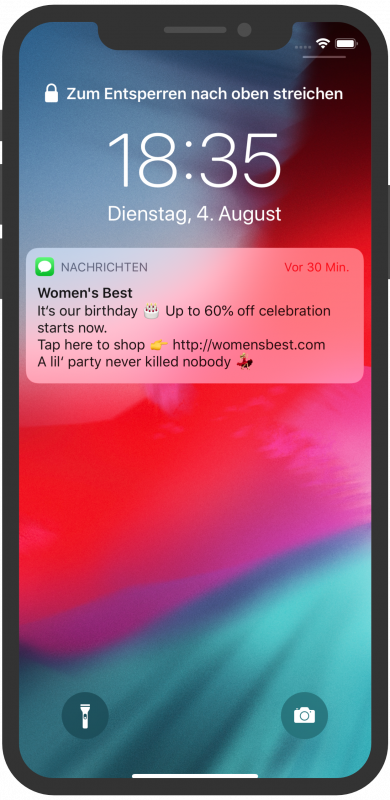
It's important to note that companies are not allowed to merely send notifications. They also have to offer customer service.
🔥 Reading tip: check out how the influencer platform stylink is more successful with iMessage newsletters than WhatsApp newsletters!
As one of the most developed messaging eco systems out there, Apple Messages for Business offers companies a wide range of options to accompany and support their customers throughout the entire customer journey. Integrated features, such as Apple Pay or descriptive topic category lists, make the experience pleasant and smooth for customers and employees.
Apple useres tend to spend more
From a technical perspective, you can reach any iOS user in the world with iMessages, no local SIM card needed! If you operate an international business, this could be a significant advantage. And even though there are less Apple than Android users, they tend to spend more. So it might be worthwile considering Apple Messages for Business as an (additional) channel for marketing notifications.
Finding the right content strategy for your one-to-many messages
Marketing notifications on messaging apps like WhatsApp, Telegram, Apple Messages for Business, or Meta's Facebook Messenger are a great way to send content quickly and directly. But what type of content should you send? Content strategy, media selection, interaction, timing, and target group are crucial for success.
As with any new medium, the question with messenger apps is: what content works for your business and your target audience? Typical questions that you should clarify in advance are:
- How often do you want to send out messages? Tip: less is more! We recommend a maximum of three newsletters per day!
- How many news topics do you want to send per message?
- Which media (emojis, pictures, videos, language) do you want to include?
- How formally or informally do you want to address your readers?
Also, pay special attention to the teaser text. These are the first seven words that appear on the lock screen — and ultimately encourage recipients to open your messages (or not).
💡 Learn how to find the right content strategy for your messenger app notifications!
How to get subscribers for your messaging notifications
When setting up your messaging broadcast channel, these are the things you should keep in mind for getting more subscribers:
- Place your widget wherever you can. Your target group can easily subscribe to your messenger newsletter through the Sinch Engage widget. Communicate the widget through all channels available to you, whether online or offline (website, e-mail signature, etc.)
- Integrate your landing page for the messaging notifications on your website, where users and customers are looking for contact, support, and information.
- Set up click-to-chat. This means, for example, that you include a link on your website, the newsletter landing page, or on any other digital platform that you use. When users clicks on this link, the corresponding messaging app opens directly. You should use or communicate this link on all your touchpoints. This ranges from your website to flyers with QR codes.
- A QR code will help you, too. It's another great way for users to access your marketing notifications directly. You can place it on your products, invoices, or flyers, and thus enable customers to subscribe to your notifications directly via a click-to-chat link.
- Use social media to promote your messaging app newsletter. Communicate the number, or use the click-to-chat link to lead people from Facebook or Instagram directly to your messenger service. On Facebook, for example, you can draw attention to your newsletter with videos or the click-to-chat links. On Twitter, you can also post video clips and share the link, while on Instagram you should add the link in your bio, and add the comment "link in bio" to content you post around your notification service.
- Keep track of all the touchpoints you have with your customers and consider using these to draw people's attention to your push notifications so that you can get as many users as possible into your messaging service.
💡Reading tip: How to grow your audience on messenger apps
Send marketing notifications on all relevant messaging apps with "Campaigns", a professional and scalable tool
For companies that want to take advantage of the benefits of sending out notifications on messenger apps, we have developed a special software solution on our all-in-one messaging platform Sinch Engage: Campaigns. With Campaigns, you can:
- 👨⚖️ ... access WhatsApp through the official WhatsApp Business API, and use it to send out notifications, and scale marketing campaigns.
- 📯... send messaging app notifications to customers on WhatsApp, Apple Messages for Business (iMessage), Facebook Messenger, Viber, Telegram, and Instagram Direct.
- 🚀... start right away, no coding skills needed — even from your home office!
- 💻... manage all messages from any messaging app centrally in your inbox.
📣 Create professional messaging campaigns on WhatsApp, Telegram, and other messaging apps!


